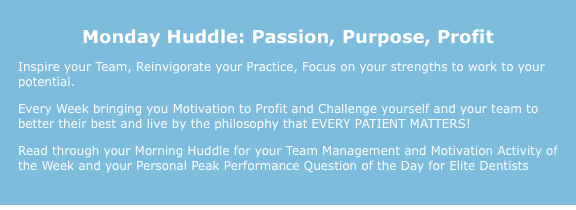You have probably heard the saying, “A confused customer never buys.” Technically, someone isn’t a ‘customer’ until they buy just like you don’t really have a patient when they just come in and visit. They have to actually do something. Exam, cleaning, ideally dentistry.
Just coming in and going through the motions doesn’t make them a patient. That’s why so many practices lose because they judge success by going through the motions not actually accomplishing anything with their patients.
If you change what you expect the outcome to be and align your actions in a way that they are focused on creating those outcomes you will then have a new outcome.
Which brings me back to last week and our discussion about money and patients using it as the reason for saying no.
If the outcome we desire is to diagnosis, present treatment, let the patients decide and then send them back out into the world, we are going to get a lot of price resistance, fee objections and overall money excuses because we haven’t made the patients want the treatment.
We have just taken them through the steps, presented the treatment as a matter of fact and then we’ve let money become the ultimate deciding factor as to whether or not they will proceed with the treatment.
Here’s the thing to know…
Patients, like all people buying anything, have really made up their minds the majority of the time BEFORE they get to the end of the buying process.
Yes, some people go certain places to ‘shop around’ instead of buy. But there isn’t much to ‘shop around’ at your practice – they don’t come to browse, they come to fix a problem.
Therefore, if between the walking in and the walking out, the only excuse a patient gives us is money you can bet that it’s a cover for some other reason, experience or communication they had during this visit.
They simply aren’t convinced this is the right thing for them. That the benefit of the treatment or the consequence of doing nothing is not worth more to them than the money they are going to pay.
The percentage of people who actually do not have any money or access to resources is so small you shouldn’t let it get in your way or even think about it. Remember, first begin with your expectation that you are going to help the patient and they are going to pay.
So, what does happen? Why don’t more patients say yes?
They are confused, they lack clarity, they weren’t compelled or they were unsold during your experience.
Essentially, they lack a firm, committed and clear clinical yes. If patients use money as the excuse, they do not see the value and therefore they have no commitment to the outcome.
Lack of clarity and creation of confusion can come from many things. It happens when patients aren’t really made a part of the process. It happens when you talk over their heads. It happens when you only talk with each other and you do not dialogue enough with them directly.
If all you did was commit to making sure that every patient is crystal clear and completely committed to the treatment, solution or next step BEFORE they exit the operatory, you will be setting up your team member for success who is going to handle the money and the schedule.
I’d like you to critique each other on this and even backtrack on a few patients lately who everyone thought were all in but they did not follow through. Then assess what you can do. Really look at this for every aspect of the practice and come up with some protocols that keeps everyone on the same page (especially the patient), when it comes to their clinical agreement (yes) in the back before moving up front.
This is more than just the triangle. This is common sense and awareness over what the patient is really thinking.
One key thing to starting doing more of is: ASKING THEM!
Can you imagine? We talk about communication all the time with you and your team members. How about improving communication effectiveness with your patients.
More questions. More listening. More asking. More engaging. More awareness.
Another way confusion is so often created and messes up clinical yeses is by giving treatment options… that is one certain way to drive patients to make a money based decision which is the exact thing we are trying to avoid.
Even if you are way above the basic mistake of giving treatment options to patients and you think you are very advanced in what you do there is a common flaw that nearly every doctor makes when discussing treatment with patients. If it’s fixed BEFORE any treatment or money is discussed it will, with almost 100% certainty, result in removing the money objection entirely from the treatment decision.
We’ll go there next week. And we’ll keep at this until every team member has been broken of any bad habits that set patients up to ‘make it about the money’ even though we know better.
When you fix these, you all of the sudden make your success much easier, less of a fight and you will have more fun everyday with patients because you won’t feel you are selling them (and they won’t feel like they are being sold). Everyone wins when the result is helping many more patients get healthy.



